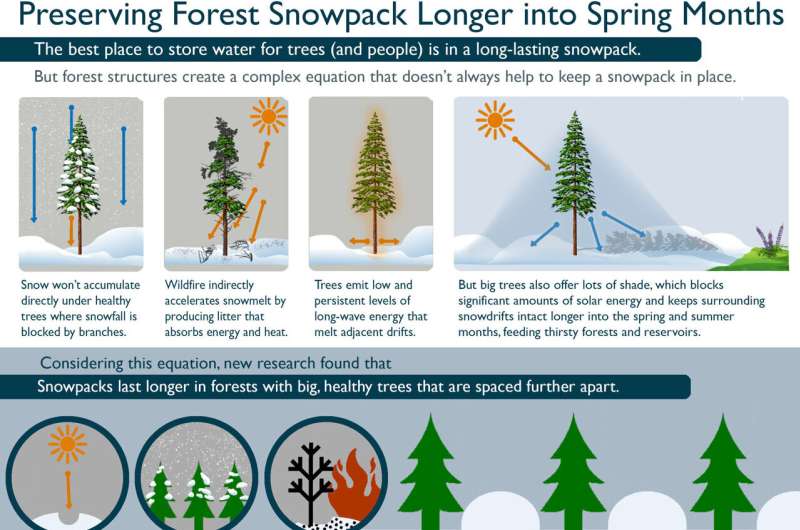Research shows big trees boost water in forests by protecting snowpack

Big trees play an outsized role in old-growth forests—from offering fire resistance to producing strong genetic offspring, big trees give forests multiple ecological advantages. New research gives managers yet another reason to honor the behemoths—big trees protect melting snowpacks in water-stressed environments. The research from Michaela Teich, Kendall Becker and Jim Lutz from the Department of Wildland Resources at Utah State University and colleague Mark Raleigh from Oregon State University, details the ecological puzzle for how big trees interact with forest snow.
A good supply of water allows trees to endure hot summer temperatures, survive wildfire and fight off attacks from invasions of bark beetles. But during the hot summers in the West, precipitation tends to be scant. A good, thick snowpack is water-in-the-bank as far as forests are concerned; the longer the winter snowpack endures into spring and summer months, the longer water is released into the soil and available to thirsty trees. That melting snow is also part of the runoff that fills the West's reservoirs and benefits communities. The goal of the research was to find ways for managers to help this essential source of water linger for longer into spring and summer months.
A hindrance for building a snowpack in a forest is, ironically, the trees themselves. Tree branches catch snow before it hits the ground and offers it back up to the atmosphere through evaporation or sublimation. The ground directly beneath big trees, cut off from the sky by branches, tends to build only a shallow snowpack, while forest floors further away enjoy deeper accumulations. Add to that equation longwave radiation—any tree with a good, solid heft to its trunks emits an invisible energy that humans can't see (as light) or feel (as heat). But the constant subtle bombardment inflicted on the adjacent snowpack adds just enough energy to pull snow back from the threshold of frozen, and to limit how long it can endure into the warm season.
But big trees aren't all bad news for snowpacks. The same, wide branches that prevent snow from reaching the ground directly under a tree also provide a cooling stretch of shade that blocks direct sunlight from melting snow across a fairly wide radius surrounding a tree. And the savings are significant; they can outweigh both the detriment of canopy cover and longwave energy.
With the balance between these factors in mind, the researchers performed calculations to determine what a forest looked like that maximized the benefits of shade, and minimized the negative factors of canopy and longwave energy. What they found was a doughnut …. at least a doughnut-shaped zone surrounding big trees where snowpack could best endure, away from the longwave energy produced by the trunk and still within the reach of the cooling shade. The best forests for long-lasting snowpack had trees that were spaced in such a way that these doughnut-shaped zones bumped up against each other, but did not overlap.
"Snow is a key resource for fresh water supply and ecosystem function. Our study highlights that conserving big trees––the very trees that often survive forest fires––in forest ecosystems where fire is part of the ecological cycle can help facilitate both," said Teich.
But spaced-out trees need to be both healthy and big for the equation to work, say the researchers. Healthy, because thick tree canopies cast the most shade. And big, because those trees are tall and cast shade further—plus being more likely to resist wildfires occurring in the West.
"This work, in a large Smithsonian-affiliated research site, lays out the fundamental issues involved in retaining snow on the ground" says Lutz. "What we need now is more investigation into the specific tree species, sizes, and densities that optimize snow retention in the different forest types of the American West."
The research was published in Ecohydrology.
More information: Michaela Teich et al, Large‐diameter trees affect snow duration in post‐fire old‐growth forests, Ecohydrology (2022). DOI: 10.1002/eco.2414
Provided by S.J. & Jessie E. Quinney College of Natural Resources, Utah State University




















